Chemosphere ( IF 8.8 ) Pub Date : 2021-09-18 , DOI: 10.1016/j.chemosphere.2021.132302 Yue Zhu 1 , Wenmin Qiu 2 , Yuhong Li 2 , Jinjuan Tan 3 , Xiaojiao Han 2 , Longhua Wu 4 , Yugen Jiang 5 , Zhiping Deng 3 , Chao Wu 6 , Renying Zhuo 2

|
Sedum plumbizincicola is an herbaceous species tolerant of excessive cadmium accumulation in above-ground tissues. The implications of membrane proteins, especially integrative membrane proteins, in Cd detoxification of plants have received attention in recent years, but a comprehensive profiling of Cd-responsive membrane proteins from Cd hyperaccumulator plants is lacking. In this study, the membrane proteins of root, stem, and leaf tissues of S. plumbizincicola seedlings treated with Cd solution for 0, 1 or 4 days were analyzed by Tandem Mass Tag (TMT) labeling-based proteome quantification (Data are available via ProteomeXchange with identifier PXD025302). Total 3353 proteins with predicted transmembrane helices were identified and quantified in at least one tissue group. 1667 proteins were defined as DAPs (differentially abundant proteins) using fold change >1.5 with p-values <0.05. The number of DAPs involved in metabolism, transport protein, and signal transduction was significantly increased after exposure to Cd, suggesting that the synthesis and decomposition of organic compounds and the transport of ions were actively involved in the Cd tolerance process. The number of up-regulated transport proteins increased significantly from 1-day exposure to 4-day exposure, from 5 to 112, 16 to 42, 18 to 44, in root, stem, and leaf, respectively. Total 352 Cd-regulated transport proteins were identified, including ABC transporters, ion transport proteins, aquaporins, proton pumps, and organic transport proteins. Heterologous expression of SpABCB28, SpMTP5, SpNRAMP5, and SpHMA2 in yeast and subcellular localization showed the Cd-specific transport activity. The results will enhance our understanding of the molecular mechanism of Cd hypertolerance and hyperaccumulation in S. plumbizincicola and will be benefit for future genetic engineering in phytoremediation.
中文翻译:

定量蛋白质组分析揭示镉胁迫下景天中膜转运蛋白的变化
Sedum plumbizincicola是一种草本植物,可以耐受地上组织中过量的镉积累。近年来,膜蛋白,尤其是整合膜蛋白在植物 Cd 解毒中的意义受到关注,但缺乏对 Cd 超富集植物的 Cd 响应膜蛋白的综合分析。在这项研究中,S. plumbizincicola根、茎和叶组织的膜蛋白通过基于串联质量标签 (TMT) 标记的蛋白质组定量分析用 Cd 溶液处理 0、1 或 4 天的幼苗(数据可通过 ProteomeXchange 获得,标识符为 PXD025302)。在至少一个组织组中鉴定并量化了总共 3353 种具有预测跨膜螺旋的蛋白质。1667 种蛋白质被定义为 DAP(差异丰度蛋白质),使用 >1.5 的倍数变化,p 值 <0.05。暴露于Cd后,参与代谢、转运蛋白和信号转导的DAPs数量显着增加,表明有机化合物的合成和分解以及离子的转运积极参与了Cd耐受过程。上调转运蛋白的数量从 1 天暴露到 4 天暴露显着增加,从 5 到 112、16 到 42,根、茎、叶各18~44个。共鉴定了 352 种 Cd 调节的转运蛋白,包括 ABC 转运蛋白、离子转运蛋白、水通道蛋白、质子泵和有机转运蛋白。的异源表达酵母和亚细胞定位中的SpABCB28、SpMTP5、SpNRAMP5和SpHMA2显示出 Cd 特异性转运活性。该结果将加深我们对S. plumbizincicola 中 Cd 超耐受和超积累的分子机制的理解,并将有利于未来植物修复中的基因工程。


























 京公网安备 11010802027423号
京公网安备 11010802027423号